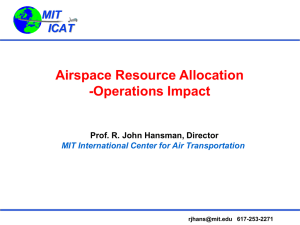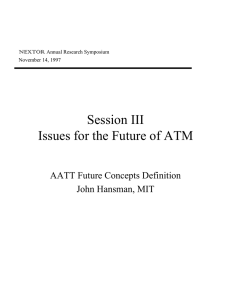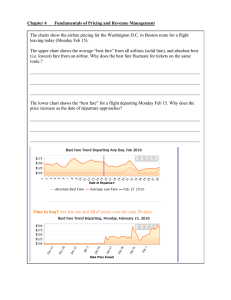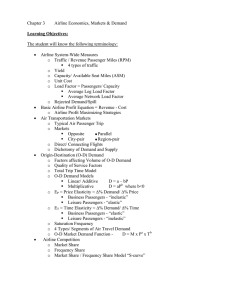Airline Economics Review MIT ICAT Dr. Peter P. Belobaba
advertisement
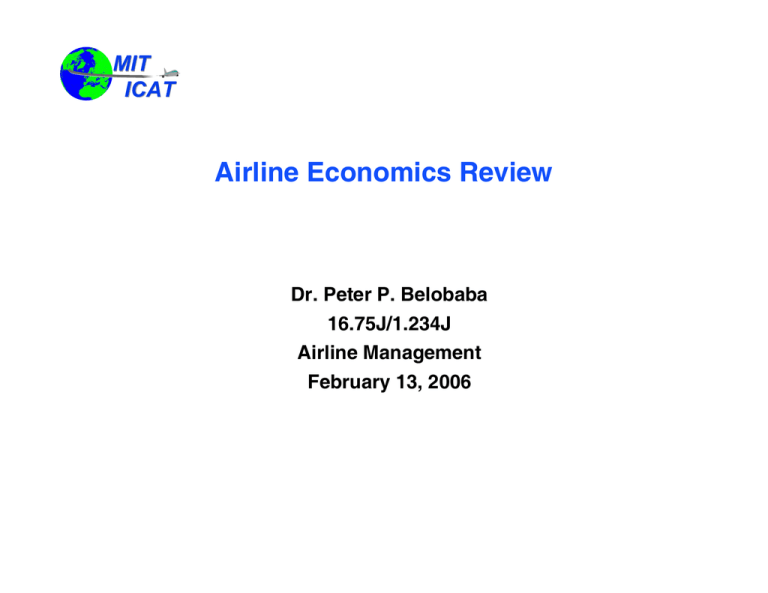
MIT ICAT Airline Economics Review Dr. Peter P. Belobaba 16.75J/1.234J Airline Management February 13, 2006 MIT ICAT Lecture Outline 1. Basic Airline Profit Model 2. Air Travel Markets – Origin-Destination Market Demand – Dichotomy of Airline Demand and Supply 3. Demand Models 4. Airline Competition – Market Share/Frequency Share Model 5. Airline Pricing Practices – Differential Pricing Strategies MIT ICAT 1. Basic Airline Profit Model Operating Profit = Revenues - Operating Expense Operating Profit = RPM x Yield - ASM x Unit Cost • The use of individual terms in this profit equation to measure airline success can be misleading: – High Yield is not desirable if ALF is too low; in general, Yield is a poor indicator of airline profitability – Low Unit Cost is of little value if Revenues are weak – Even ALF on its own tells us little about profitability, as high ALF could be the result of extremely low fares (yields) • Airline profit maximizing strategy is to increase revenues, decrease costs, but the above terms are interrelated. MIT ICAT Yield vs. Distance -- Top 50 O+D Markets 70 60 Yield (cents/RPM) 50 40 30 20 10 0 0 500 1000 1500 O-D Market Distance (miles) 2000 2500 3000 MIT ICAT Additional Airline Measures • Average Stage Length – Average non-stop flight distance – Aircraft Miles Flown / Aircraft Departures – Longer average stage lengths associated with lower yields and lower unit costs (in theory) • Average Passenger Trip Length – Average distance flown from origin to destination – Revenue Passenger Miles (RPMS) / Passengers – Typically greater than average stage length, since some proportion of passengers will take more than one flight (connections) • Average Number of Seats per Flight Departure – Available Seat Miles / Aircraft Miles Flown – Higher average seats per flight associated with lower unit costs (in theory) MIT ICAT 2. Air Travel Markets • City-pair market – Demand for air travel between Boston and Chicago • Airport-pair market – City-pair demand disaggregated to different airports BOS-O’Hare and BOS-Midway – Parallel air travel markets • Region-pair market – Demand between entire Boston metropolitan area and Chicago metropolitan area – Additional parallel airport-pair markets including Providence and Manchester to O’Hare and Midway MIT ICAT Distinct and Separate O-D Markets MIT ICAT Origin-Destination Market Demand • Air travel demand is defined for an origin-destination market, not a flight leg in an airline network: – Number of persons wishing to travel from origin A to destination B during a given time period (e.g., per day) – Includes both passengers starting their trip at A and those completing their travel by returning home to B (opposite markets) – Typically, volume of travel measured in one-way passenger trips between A and B, perhaps summed over both directions • Airline networks create complications for analysis of market demand and supply: – Not all A-B passengers will fly on non-stop flights from A to B, as some will choose one-stop or connecting paths – Any single non-stop flight leg A-B can also serves many other O-D markets, as part of connecting or multi-stop paths MIT ICAT Joint Supply to O-D Markets BOS-IAH Flight Top O-D Markets By Volume 40 Average Bookings 30 20 10 0 IAH LAS MEX PHX HNL CUN MSY ACA PVR SJD SAN SAT SNA ABQ AUS SFO TUS BZE DFW LAX CZM GUM ZIH MIT ICAT Dichotomy of Demand and Supply • Inherent inability to directly compare demand and supply at the “market” level • Demand is generated by O-D market, while supply is provided as a set of flight leg departures over a network of operations • One flight leg provides joint supply of seats to many O-D markets – Number of seats on the flight is not the “supply” to a single market – Not possible (or realistic) to determine supply of seats to each O-D • Single O-D market served by many competing airline paths – Tabulation of total O-D market traffic requires detailed ticket coupon analysis MIT ICAT Implications for Analysis • Dichotomy of airline demand and supply complicates many facets of airline economic analysis • Difficult, in theory, to answer seemingly “simple” economic questions, for example: – Because we cannot quantify “supply” to an individual O-D market, we cannot determine if the market is in “equilibrium” – Cannot determine if the airline’s service to that O-D market is “profitable”, or whether fares are “too high” or “too low” – Serious difficulties in proving predatory pricing against low-fare new entrants, given joint supply of seats to multiple O-D markets and inability to isolate costs of serving each O-D market • In practice, assumptions about cost and revenue allocation are required: – Estimates of flight and/or route profitability are open to question MIT ICAT 3. Demand Models • Demand models are mathematical representations of the relationship between demand and explanatory variables: – Based on our assumptions of what affects air travel demand – Can be linear (additive) models or non-linear (multiplicative) – Model specification reflects expectations of demand behavior (e.g., when prices rise, demand should decrease) • A properly estimated demand model allows airlines to more accurately forecast demand in an O-D market: – As a function of changes in average fares – Given recent or planned changes to frequency of service – To account for changes in market or economic conditions MIT ICAT Airline Demand • Demand for carrier flight f of carrier i in OD market j is a function of: – Characteristics of flight f • Departure time, travel time, expected delay, aircraft type, in-flight service, etc. • Price – Characteristics of carrier i • Flight schedule in market j (frequency, timetable), airport amenities of carrier, frequent flyer plan attractiveness, etc. – Market characteristics • Distance, business travel between two cities, tourism appeal – Characteristics (including price) of all rival products: • Other flights on carrier i • Flights on other carriers in market j (carrier and flight characteristics) • Competing markets’ products (other airports serving city-pair in j, other transport modes, etc.) MIT ICAT Total Trip Time from Point A to B • Next to price of air travel, most important factor affecting demand for airline services: – Access and egress times to/from airports at origin and destination – Pre-departure and post-arrival processing times at each airport – Actual flight times plus connecting times between flights – Schedule displacement or wait times due to inadequate frequency • Total trip time captures impacts of flight frequency, path quality relative to other carriers, other modes. – Reduction in total trip time should lead to increase in total air travel demand in O-D market – Increased frequency and non-stop flights reduce total trip time – Increases in total trip time will lead to reduced demand for air travel, either to alternative modes or the “no travel” option MIT ICAT Total Trip Time and Frequency T = t(fixed) + t(flight) + t(schedule displacement) – Fixed time elements include access and egress, airport processing – Flight time includes aircraft “block” times plus connecting times – Schedule displacement = (K hours / frequency), meaning it decreases with increases in frequency of departures • This model is useful in explaining why: – Non-stop flights are preferred to connections (lower flight times) – More frequent service increases travel demand (lower schedule displacement times) – Frequency is more important in short-haul markets (schedule displacement is a much larger proportion of total T) – Many connecting departures through a hub might be better than 1 non-stop per day (lower total T for the average passenger) MIT ICAT Simple Market Demand Function • Multiplicative model of demand for travel O-D per period: D = M x Pa x Tb where: M = market sizing parameter (constant) that represents underlying population and interaction between cities P = average price of air travel T = total trip time, reflecting changes in frequency a,b = price and time elasticities of demand • We can estimate values of M, a, and b from historical data sample of D, P, and T for same market: – Previous observations of demand levels (D) under different combinations of price (P) and total travel time (T) MIT ICAT Multiple Demand Segments MIT ICAT Demand Models by Segment MIT ICAT Demand Models by Segment MIT ICAT 4. Airline Competition • Airlines compete for passengers and market share based on: – Frequency of service and departure schedule on each route served – Price charged, relative to other airlines, to the extent that regulation allows for price competition – Quality of service and products offered -- airport and in-flight service amenities and/or restrictions on discount fare products • Passengers choose combination of flight schedules, prices and product quality that minimizes disutility of air travel: – Each passenger would like to have the best service on a flight that departs at the most convenient time, for the lowest price MIT ICAT Market Share / Frequency Share • Rule of Thumb: With all else equal, airline market shares will approximately equal their frequency shares. • But there is much empirical evidence of an “S-curve” relationship as shown on the following slide: – Higher frequency shares are associated with disproportionately higher market shares – An airline with more frequency captures all passengers wishing to fly during periods when only it offers a flight, and shares the demand wishing to depart at times when both airlines offer flights – Thus, there is a tendency for competing airlines to match flight frequencies in many non-stop markets, to retain market share MIT ICAT MS vs. FS “S-Curve” Model MIT ICAT S-Curve Model Formulation MIT ICAT 5. Airline Prices and O-D Markets • Like air travel demand, airline fares are defined for an O-D market, not for an an airline flight leg: – Airline prices for travel A-B depend on O-D market demand, supply and competitive characteristics in that market – No economic theoretical reason for prices in market A-B to be related to prices A-C, based strictly on distance traveled – Could be that price A-C is actually lower than price A-B – These are different markets with different demand characteristics, which might just happen to share joint supply on a flight leg • Dichotomy of airline demand and supply makes finding an equilibrium between prices and distances more difficult. MIT ICAT Price Elasticity of Demand • Definition: Percent change in total demand that occurs with a 1% increase in average price charged. • Price elasticity of demand is always negative: – A 10% price increase will cause an X% demand decrease, all else being equal (e.g., no change to frequency or market variables) – Business air travel demand is slightly “inelastic” (0 > Ep > -1.0) – Leisure demand for air travel is much more “elastic” (Ep < -1.0) – Empirical studies have shown typical range of airline market price elasticities from -0.8 to -2.0 (air travel demand tends to be elastic) – Elasticity of demand in specific O-D markets will depend on mix of business and leisure travel MIT ICAT Implications for Airline Pricing • Inelastic (-0.8) business demand for air travel means less sensitivity to price changes: – 10% price increase leads to only 8% demand reduction – Total airline revenues increase, despite price increase • Elastic (-1.6) leisure demand for air travel means greater sensitivity to price changes – 10% price increase causes a 16% demand decrease – Total revenues decrease given price increase, and vice versa • Recent airline pricing practices are explained by price elasticities: – Increase fares for inelastic business travelers to increase revenues – Decrease fares for elastic leisure travelers to increase revenues MIT ICAT Time Elasticity of Demand • Definition: Percent change in total O-D demand that occurs with a 1% increase in total trip time. • Time elasticity of demand is also negative: – A 10% increase in total trip time will cause an X% demand decrease, all else being equal (e.g., no change in prices) – Business air travel demand is more time elastic (Et < -1.0), as demand can be stimulated by improving travel convenience – Leisure demand is time inelastic (Et > -1.0), as price sensitive vacationers are willing to endure less convenient flight times – Empirical studies show narrower range of airline market time elasticities from -0.8 to -1.6, affected by existing frequency MIT ICAT Implications of Time Elasticity • Business demand responds more than leisure demand to reductions in total travel time: – Increased frequency of departures is most important way for an airline to reduce total travel time in the short run – Reduced flight times can also have an impact (e.g., using jet vs. propeller aircraft) – More non-stop vs. connecting flights will also reduce T • Leisure demand not nearly as time sensitive: – Frequency and path quality not as important as price • But there exists a “saturation frequency” in each market: – Point at which additional frequency does not increase demand MIT ICAT Theoretical Pricing Strategies • For determining prices to charge in an O-D market, airlines can utilize one of following economic principles: – Cost-based pricing – Demand-based pricing – Service-based pricing • In practice, most airline pricing strategies reflect a mix of these theoretical principles: – Prices are also highly affected by competition in each O-D market – In the US, severe competition in some markets has led to “pricebased costing”, meaning airlines must reduce costs to be able to match low-fare competitors and passengers’ price expectations MIT ICAT Price Discrimination vs. Product Differentiation • Price discrimination: – The practice of charging different prices for same product with same costs of production – Based solely on different consumers’ “willingness to pay” • Product differentiation: – Charging different prices for products with different characteristics and costs of production • Current airline fare structures reflect both strategies: – Differential Pricing based on differentiated fare products – But higher prices for fare products targeted at business travelers are clearly based on their willingness to pay MIT ICAT Airline Pricing Practices • Differential pricing presents a trade-off to customers between inconvenience and price levels: – Business travelers are “willing” to pay higher fares in return for more convenience, fewer restrictions on use of tickets – Leisure travelers less “willing” to pay higher prices, but accept disutility “costs” of restrictions on low fare products • Economic concept of “willingness to pay” (WTP) is defined by the theoretical price-demand curve: – “Willingness” does not mean “happiness” in paying higher prices – Differential pricing attempts to make those with higher WTP purchase the less restricted higher-priced options MIT ICAT Differential Pricing Theory (circa 2000) • Market segments with different “willingness to pay” for air travel • Different “fare products” offered to business versus leisure travelers • Prevent diversion by setting restrictions on lower fare products and limiting seats available • Increased revenues and higher load factors than any single fare strategy MIT ICAT Why Differential Pricing? • It allows the airline to increase total flight revenues with little impact on total operating costs: – Incremental revenue generated by discount fare passengers who otherwise would not fly – Incremental revenue from high fare passengers willing to pay more – Studies have shown that most “traditional” high-cost airlines could not cover total operating costs by offering a single fare level • Consumers can also benefit from differential pricing: – Most notably, discount passengers who otherwise would not fly – It is also conceivable that high fare passengers pay less and/or enjoy more frequency given the presence of low fare passengers MIT ICAT Traditional Approach: Restrictions on Lower Fares • Progressively more severe restrictions on low fare products designed to prevent diversion: – Lowest fares have advance purchase and minimum stay requirements , as well as cancellation and change fees – Restrictions increase the inconvenience or “disutility cost” of low fares to travelers with high WTP, forcing them to pay more – Studies show “Saturday night minimum stay” condition to be most effective in keeping business travelers from purchasing low fares • Still, it is impossible to achieve perfect segmentation: – Some travelers with high WTP can meet restrictions – Many business travelers often purchase restricted fares MIT ICAT Example: Restriction Disutility Costs MIT ICAT Fare Simplification: Less Restricted and Lower Fares • Recent trend toward “simplified” fares – compressed fare structures with fewer restrictions – Initiated by some LFAs and America West, followed by Alaska – Most recently, implemented in all US domestic markets by Delta, matched selectively by legacy competitors • Simplified fare structures characterized by: – No Saturday night stay restrictions, but advance purchase and nonrefundable/change fees – Revenue management systems still control number of seats sold at each fare level • Higher load factors, but 10-15% lower revenues: – Significantly higher diversion with fewer restrictions Example: BOS-ATL Simplified Fares Delta Air Lines, April 2005 MIT ICAT One Way Bkg Advance Minimum Fare ($) Cls Purchase Stay $124 T 21 days 0 $139 U 14 days 0 $184 L 7 days 0 $209 K 3 days 0 $354 B 3 days 0 $404 Y 0 0 $254 $499 A F 0 0 0 0 Change Fee? $50 $50 $50 $50 $50 No Comment Non-refundable Non-refundable Non-refundable Non-refundable Non-refundable Full Fare No No First Class First Class MIT ICAT Revenue Impact of Each “Simplification” 65,000 60,000 .5% 50,000 .8% -16 -0 55,000 .6% -29 45,000 40,000 % -45 35,000 30,000 Fully Restricted Remove AP Remove Sat Night Min Stay Remove All Restr, Keep AP Remove All Restr and AP MIT ICAT Loads by Fare Class 100 88.1 87.8 90 81.6 79.8 82.7 80 70 60 50 40 FC 6 30 FC 5 20 FC 4 FC 3 10 FC 2 0 Fully Restricted Remove AP Remove Sat Night Min Stay Remove All Restr, Keep AP Remove All Restr and AP FC 1 MIT ICAT Impacts on Differential Pricing Model • Drop in business demand and willingness to pay highest fares • Greater willingness to accept restrictions on lower fares • Reduction in lowest fares to stimulate traffic and respond to LCCs • Result is lower total revenue and unit RASM despite stable load factors
